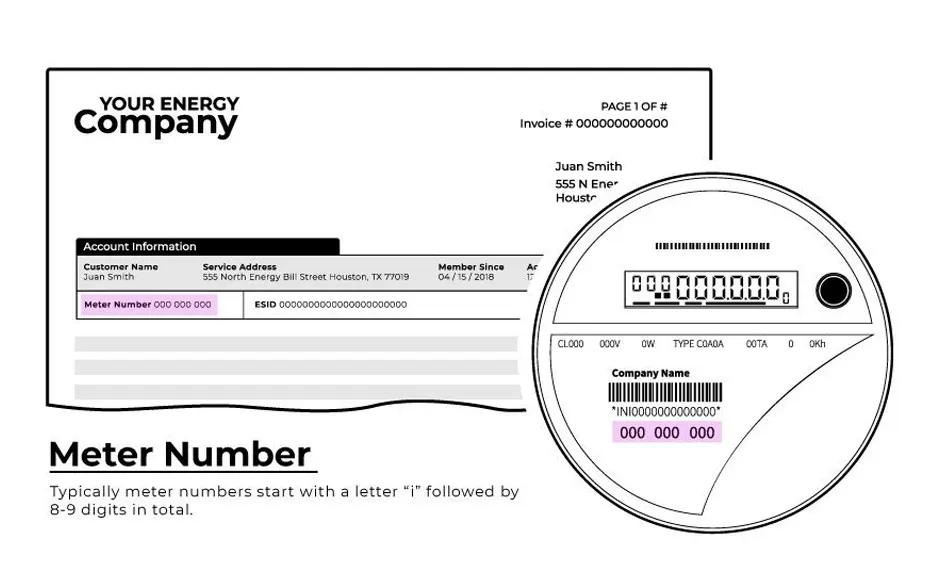Compare Power Rates in Texas & Save Money
Compare with our smart app to find the right plan

Order your Plan through EnerWisely and Compete to Win One Year of Free Electricity
(Up to $2,000 value | Promo details )

To get the best electricity rates in Texas it is to good understand the ins and outs of the market. In other words, from how rates are determined to how to compare rates between companies.
Our guide will give a rundown on how electricity rates work. This knowledge will empower you to find the cheapest electricity rate in Texas.
We’ll cover electricity rates for the three main branches of the energy sector and how they affect your pocket:
· Power generators.
· Retail electric providers (REPs).
· Transmission and distribution service providers (TDSPs).
What Are The Electricity Rates per kWh in Texas?
When comparing electricity rates in Texas, the primary factor to consider is the price per kilowatt hour (kWh). A kilowatt-hour measures how much energy is supplied and consumed in your home in an hour.
Kilowatt hours are measured using sophisticated metering equipment. The costs of monitoring and maintaining the meter, lines, and poles fall to one of Texas’ five transmission/distribution service providers.
One of the reasons why electricity rates are compared by zip code, is because there is a delivery charge that depend on the utility in each service area.
Service providers use rates like fixed, variable, and indexed. The methodology behind these electricity rates is very different. However, the final product should look the same: an easy to understand price per kWh, measured in cents.
One note on Retail Electricity Providers (REPs) and electricity rates: REPs in Texas are not regulated. This means they are not required to disclose how they arrived at their price per kWh. REPs can change your price per kWh without warning or explanation.
This could happen because the REP did not accurately predict demand. So, it’s important to check the history and reputation of your REP instead of focusing solely on the cheapest prices.

How the costs travels from Generators to Providers and End Up in your Electricity Rates
Your REP is not the same entity that generates your electricity. One of Texas’ 1030+ wind, solar, coal, hydro electric, and nuclear power generators is responsible for this.
These generators, or power plants, must create electricity to meet demand in real time. Therefore, their prices are based on predictions and forecasts using historical data.
Generators prefer to price their product based on time windows, generally between 15 minutes to an hour. This means 15 minutes of electricity could cost more at the beginning of the evening when the sun is still out. But typically generators charge less for electricity rates later in the night. Now you get the idea, that’s why some electricity plans offer free nights.
Generators across the state forecast how much it will cost to generate electricity during a given time window. Then, they submit these estimates as bids to the Electric Reliability Council of Texas (ERCOT). Next, the electricity providers (REPs) accept the lowest bids to purchase enough electricity to meet their forecasted demand.
Electricity Generation Fixed costs:
Fixed costs usually don’t change over time, such as capital expenses related to equipment, regulation, or the facility itself. In Texas, fixed costs are generally lower than in most other states.
Electricity Generation Variable costs:
As the name implies, variable costs are subject to frequent and sometimes dramatic changes in response to market conditions. The most common variable cost that generators deal with is fuel. However, something like labor, land leases, and maintenance can also become variable as the market fluctuates.
Renewable generators like wind or solar farms of course use free fuel. So their costs are concentrated on labor and the land or facilities for their generators. Other generators, like coal or nuclear plants, can vary greatly in response to the price of fuels.
Two More Factors Driving the Cost of Electricity Generation
The impact of Supply and Demand on electricity rates
Electricity can’t be stored in a warehouse until it’s needed. It must be generated in real time in response to demand.
Every week night, millions of consumers come home and turn on their lights and the air conditioning or heater. As demand increases like this, REPs need more electricity all at once to keep up with consumer demand.
At times of higher demand, generators can charge more for their product since more is needed imminently to cover demand.
Conversely, generators cannot charge as much during the evening when everyone has gone to sleep. During these times, prices will fall because demand has fallen.
Some generators (such as nuclear plants) cannot easily power down, so they keep running even when demand isn’t high. This surplus will drive prices down further and in some rare cases even cause prices to drop below zero.
Because of how supply and demand impact the rates, all pricing from generators and REPs has to be done in advance.
How Seasonal Fluctuations impact Texas electricity prices
In Texas, electricity generators are not regulated and can charge any price for their product. It’s up to the market (REPs) to determine if the price is fair for the given period.
The primary factor that influences demand is weather. But factors like the time of day, weekends, natural disasters, and even scheduled maintenance can affect the cost of electricity.
During the summer, particularly July and August, electricity rates rise to their highest in Texas. This is due to soaring demand created by millions of air conditioners running at the same time.
How utility companies affect your electricity rates
Transmission/Distribution Service Providers (TDSPS or TDUs) are sill fully subject to Texas energy market state regulations.
The Public Utilities Commission of Texas (PUCT) is responsible for overseeing the operations of TDSPs.
This includes approving rates, infrastructure upgrades, setting safety requirements, and directing investments into new technologies or lines.
Responsibilities and challenges of Texas utility companies
TDP’s are responsible for providing a service that meets the state’s regulation regarding safety, performance, and consumer protections. In exchange for that, TDSPs are the sole owners of the state’s power lines, poles, and meters.
They alone profit from the use of electric equipment and infrastructure. Plus, any new generator or REP that sells electricity gets their delivery service from the TDSPs.
The downside of this sole ownership is its responsibility.
TDSPs are not just sitting around. They are responsible for delivering power to ERCOT’s 26 million customers. This requires constant maintenance of facilities, powerlines, and poles.
This means TDSPs are the companies on call in emergencies. They’ll be the ones sending workers to repair fallen or damaged power lines.
Besides regular maintenance, TDSPs must upgrade their infrastructure to keep up with new technology and evolving electricity generation. They also need to make a profit, or else they would have no incentive to provide the service.
These responsibilities come with costs. Ultimately REPs, generators, and Texas’ power consumers pay for it. The PUCT calculates these costs and sets a base rate , determining what TDSPs charge REPs for their services.
The Weather and Peak Demand Drive Texas Electricity Rates
In the summer of 2022, Texans’ saw all time heat and electricity rate records threatened across the state. The extreme heat of the summer sun places a tremendous strain on Texas’ energy grid.
To meet this kind of demand, infrastructure needs to be in place in advance. A demand spike could happen at any time, and the infrastructure needs to be able to handle it. That kind of power supply surge needs to last over a sustained period without maintenance or downtime.
This means PUCT determines the prices that TDSPs can charge based on peak demand capacity, even during months with lower demand.
In short, the cost of maintaining such a large capacity persists even when that capacity isn’t in use.
The PUCT maintains an annual rate comparison page with historical data. It gives you an idea of prices during the most expensive months and general fluctuations in electricity rates.
Also the EIA (Energy Information Administration) tracks electricity rates in all states across the nation. This includes residential electricity rates, commercials and industrial rates. They also publish historial information for estimated electric bills in Texas.
How to Compare Electricity Plans
Texan’s have the power to choose energy companies and switch electric providers. However with more 100 light companies, having many energy options can be overwhelming. So to get a low monthly electric bill you need to compare electricity plans and rates in Houston, Dallas, and other Texas competitive markets.
Most people are familiar with electric rates comparison sites to shop for electricity in Texas. Most of them seem easy to use as they only ask you to enter your zip code. Then you only use filters to find green energy or any other plan that you like.
However, be careful, behind that perceived simplicity there is a huge blind spot. This is because none of those websites can compared plans based on your real electricity consumption.
So, the smart and easiest way to compare electricity rates in Texas is to let EnerWisely do it for you.
Our free and smart electricity rate comparison tool is available 24/7. We’ll help you link your consumption data to automate and simplify the process. You will get easy to understand matching scores that tell you what is the cheapest electricity plan for you.
However, it doesn’t hurt to know more about how electricity rates are determined, so read on.
EnerWisely is the smart, and easy way to compare energy rates in Texas.
HERE IS HOW IT WORKS:
1- First of all, signup for FREE to link your consumption history and automate the process. All you need is your address, meter number, and the name of your electricity provider.
2- Next, enter the things that matter to you when comparing electricity rates. EnerWisely can evaluate price, renewable, provider rating and compare versus your current plan if you know your rates and cancelation fees.
3- That’s it, Order your perfect plan and start saving. Your top matches are scored and ranked based on how well they work for you.
In just minutes, EnerWisely compares multiple electricity companies, plans and rates to find the best deal for you based on your consumption. Once you set up your account, the process is automatic.
A much better comparison tool than any other free or paid service in Texas, including ogres, wizards, bots and genies. So know you know, start taking advantage today.
Feel free to visit your dashboard as often as you like to make sure that you’re always getting the best deals. Also take advantage of all the perks that EnerWisely offers including your home energy efficiency audit.
EnerWisely works for customers of all electricity companies in Texas competitive markets.
But hurry, this free offer is coming to an end soon.

Texas Electricity Rates FAQ
Get the Best Electricity Rates and Maximize your Savings in Texas
As discussed above, several factors go into how REPs assign prices to their services. A general understanding of market trends, historical data, and REP rating can be helpful.
However, you don’t need an expert to shop electric rates and choose the cheapest energy plan for your home.
Fortunately, the smart shopping tool to compare all these details based on your consumption is now available. EnerWisely can help you simplify and save money by automatically matching you with the cheapest electricity rate in your area.
And if you really want to lower your electricity bills, let EnerWisely help you improve your energy efficiency too.
Click here start comparing electricity rates and start saving money today using EnerWisely free online tool.
Current Texas Electricity Rates
| Plan Name | Term | Rate/KWh |
|---|
These Electricity rates were updated on . The pricing shown is based on an exact usage of 1000 KWh. Price include all fees, and delivery charges. The plans shown are for Zip code – 75201.
EnerWisely Keeps Your Data Safe & Private.

128-bit encryption to protect the transmission of your data to our site.

Complies with the US Department of Energy DataGuard Privacy Standard.
Smart electricity rates comparison base on your consumption

Smart up your power to choose, find the best deal and avoid surprise bills
Are you missing out on savings?



